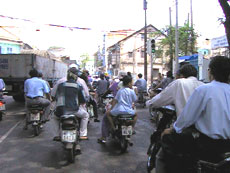
I am traveling on the Saigon-Pan Thiet highway, a passenger in a chauffeured SUV. Ahead of us is a small bus. I can see the passengers inside watching a video—a car chase. This is a few moments after our SUV pulls out to pass a truck which then pulls out in front of us to pass another truck, forcing us to hit the left-hand shoulder and pass both of them, for about the third time that night. A few minutes before, we have slammed on the brakes to pull up short behind a gasoline truck sitting beached in the middle of the highway. And regularly we pull straight into oncoming traffic, honking and flashing our lights at the vehicle speeding toward us, until finally we are forced to elbow some car onto the shoulder to get back in line with seconds to spare.
But by all means, Vietnamese bus passengers, relax with your car chase video. It seems a little like hookers watching porn films on their days off, but I guess if it's got Steve McQueen it still counts as escapism.
I feel as though I've been on this road forever. The day began on the rebound from an evening bout of food poisoning, not the last such episode of my Vietnam stay. After a flight from Hanoi, my tanks are close to drained. When the driver meets me at the airport in Ho Chi Minh City to take me up the coast to a seaside town located near Pan Thiet, I ask him how long it will take. He holds up four fingers. Forty minutes—about what I expected. Two and a half hours later I am realizing that I got the temporal units wrong. This is a four hour trek down a very dark road, and now I am wondering whether death will come instantaneously, or simply through accelerated aging.
Cart and driver
Vietnamese traffic is different. Different rules, different assumptions, entirely different operating principles. Consider: the central organizing idea of North American road safety -- that it is wrong to pull your car across the median and into the path of an oncoming vehicle -- does not apply in Vietnam. Here it is often perfectly acceptable. When you pull out, the oncoming vehicle will be expected to politely hit the shoulder and let you go by. However, if the oncoming vehicle begins vigorous headlight flashing as you approach head-on, it means trouble. He is telling you that he is currently unable to hit the shoulder for some reason—perhaps a tractor or an ox-cart or an unusually thick concentration of motorbikes on his right. You must try to squeeze back onto your side of the road, perhaps by sideswiping the three-wheeled cart you are attempting to pass. The cart person will understand. It happens.
On one black stretch of highway we come upon a casualty, a smashed motorbike in the middle of the road. The driver has either walked or been carried away and the unlit pavement is too dark to show blood. I hope the damage has only been to mobility. And I hope it wasn't a family vehicle. Vietnamese motorcycles are often as crowded as a minivan bound for a daycare.
Motorbikes on a Vietnamese highway are not considered an impediment for a larger vehicle until their numbers reach a certain mass. If it's only a few cycles they are expected to make their own way, flowing around whatever big fish might pass. Motorbikes seem to have almost no rights on Vietnamese roads (except the intrinsic right of every Vietnamese vehicle to honk incessantly). They occupy a piece of asphalt only through the grace and favour of bigger vehicles, and as soon as someone honks at them they must surrender that ground. But they are also free agents unbound by even the few rules governing cars and trucks—red lights, for example. Motorbikes sail about wherever they please, sometimes against the current.
Brakes are overrated
It's remarkable what you can carry on a motorbike: sacks of fruit, flats of bottles, piles of straw mats, furniture, great upside-down bouquets of slaughtered chickens, bundles of long bamboo. I saw one rider carrying two live pigs in a tubular cage. Everyone looked comfortable.
Vietnamese roads work on a sonar system. Drivers honk to announce their intentions and just generally to send out call signals. A driver approaching from behind honks to say he's coming through, an approaching driver honks to say the same. A Vietnamese brake specialist must be the national equivalent of the Maytag repairman—brakes appear to be used only as a last resort. (One of our nearest misses comes when the truck in front of us hits the brakes at the sight of a cop.)
Ever since the sun set behind a range of Saigon billboards, things have been getting hairier out here. Vehicles swim out of the dark in bewildering variety— pedal rickshaws, three-wheeled moto-carts, tractors, lightless bicycles, ox- carts (with oxen), covered army trucks, tankers, the occasional German sedan. One of the few vehicles able to blow past us, a sleek new Mercedes, is forced to slam on the brakes moments later just short of a massive truck-and-trailer rig, blithely straddling the highway in the midst of a slow U-turn.
At least on the trip to Pan Thiet I am king of the road, weaving through the motorized thicket in air-conditioned, four-wheel drive luxury. There are worse ways to travel in Vietnam, and I would not be spared them. A subsequent trip up the Mekong Delta would introduce me to that legendary form of travel, the Vietnamese bus.
Ours would be run by a cowboy and his sidekick, a screamer. While the cowboy would hit the gas and blast the horn at objects approaching our windshield very rapidly through no fault of their own, the screamer would hang out the side door of the bus, yippee-ki-aying at anything in the way: "AY-a-AY-a-AY-YAAY!" Our intrepid pilot would squeeze one bus off the road by getting six inches off his back bumper at full speed, quickly swerving when it finally braked to pull over. He would earn some approving murmurs and a few thumbs-up from the passengers for that move. As for me, I would note the way he held his cell phone in one hand while waving at passing buses with the other (more than once, I swear). The little girl beside me would be throwing up into a bag. She would strike me as a very sensible young lady.
Coffee break?
But that bit of fun was yet to come. Now it's three hours out of Saigon and, air-conditioned SUV or not, I am feeling seriously wilted. So many seat-clutching moments, so many sharp intakes of breath as potential catastrophes disappear in our wake. Bullying and brinksmanship are the rule. Swerving, three-abreast, close-shave incidents that would provide years of family stories back home are experienced here by the mile.
At last we pull across the road for gas. Free with the fill-up is a tall glass of Vietnamese iced coffee. If traffic is the bane of this nation, coffee is the lifeblood—the Vietnamese make a kicking brew and serve it up cold. I knock back my glass and we're back in the truck.
Things have changed. I am no longer sucking fumes. I'm alert and watchful. And suddenly the road seems to make a kind of sense. We weave, they weave, it all weaves together. I cannot recommend this sort of vehicular madness and yet it's hard to escape the overall impression that, in context at least, something about the Vietnamese system works rather well. Slowdowns are few— people find a way to keep moving at all costs. They are playing chess on a board we use for checkers.
We pass through Pan Thiet and the traffic thins. My chauffeur, a relatively sane fellow compared to some in whose hands I would later place my life, bids me adieu. Days later we would make the four-hour return journey together in relative calm, a Saturday afternoon drive with plenty of time to contemplate just how much a person can eventually get used to.
Steve Burgess is on a solo tour of several Asian countries. Below are his previous dispatches for The Tyee:
















Tyee Commenting Guidelines
Comments that violate guidelines risk being deleted, and violations may result in a temporary or permanent user ban. Maintain the spirit of good conversation to stay in the discussion.
*Please note The Tyee is not a forum for spreading misinformation about COVID-19, denying its existence or minimizing its risk to public health.
Do:
Do not: